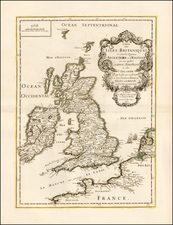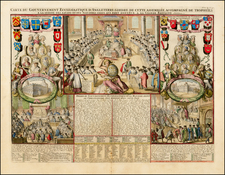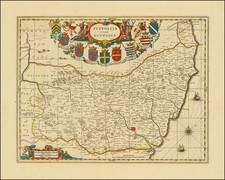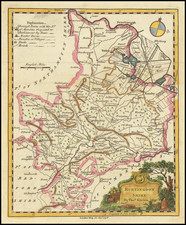Highly detailed working sea chart, illustrating the region from Dover Harbor in the south to Margate Sand, published by the British Admiralty.
Includes sailing directions, profile views (including several lighthouses) and other details. Formerly the property of Coode Matthews, Fitzmaurice & Wilson of 9 Victoria Street, in London. In the late 19th and early 20th century, Coode Matthews was the engineering firm which had charge of the harbor at Dover, along with the harbors at Colombo and Singapore and were consulting engineers to the Colonial Crown Agents for a number of other British Colonial harbors.
The Downs are a roadstead or area of sea in the southern North Sea near the English Channel off the east Kent coast, between the North and the South Foreland in southern England. In 1639, the Battle of the Downs took place here, when the Dutch navy destroyed a Spanish fleet which had sought refuge in neutral English waters. From Elizabethan times, the presence of Downs helped to make Deal one of the premier ports in England and in the 19th century, it was equipped with its own telegraph and timeball tower to enable ships to set their marine chronometers.
The Downs served in the age of sail as a permanent base for warships patrolling the North Sea and a gathering point for refitting of newly built ships coming out of Chatham Dockyard, such as the HMS Bellerophon. It formed a safe anchorage during heavy weather, protected on the east by the Goodwin Sands and on the north and west by the coast. The Downs also lie between the Strait of Dover and the Thames Estuary, so both merchant ships awaiting an easterly wind to take them into the English Channel and those going up to London gathered there, often for quite long periods. According to the Deal Maritime Museum and other sources, there are records of as many as 800 sailing ships at anchor at one time.
The British Admiralty has produced nautical charts since 1795 under the auspices of the United Kingdom Hydrographic Office (HO). Its main task was to provide the Royal Navy with navigational products and service, but since 1821 it has also sold charts to the public.
In 1795, King George III appointed Alexander Dalrymple, a pedantic geographer, to consolidate, catalogue, and improve the Royal Navy’s charts. He produced the first chart as the Hydrographer to the Admiralty in 1802. Dalrymple, known for his sticky personality, served until his death in 1808, when he was succeeded by Captain Thomas Hurd. The HO has been run by naval officers ever since.
Hurd professionalized the office and increased its efficiency. He was succeeded by the Arctic explorer Captain William Parry in 1823. By 1825, the HO was offering over seven hundred charts and views for sale. Under Parry, the HO also began to participate in exploratory expeditions. The first was a joint French-Spanish-British trip to the South Atlantic, a voyage organized in part by the Royal Society of London.
In 1829, Rear-Admiral Sir Francis Beaufort was appointed Hydrographer Royal. Under his management, the HO introduced the wind force scale named for him, as well as began issuing official tide tables (1833). It was under Beaufort that HMS Beagle completed several surveying missions, including its most famous voyage commanded by Captain FitzRoy with Charles Darwin onboard. When Beaufort retired in 1855, the HO had nearly two thousand charts in its catalog.
Later in the nineteenth century, the HO supported the Challenger expedition, which is credited with helping to found the discipline of oceanography. The HO participated in the International Meridian Conference which decided on the Greenwich Meridian as the Prime Meridian. Regulation and standardization of oceanic and navigational measures continued into the twentieth century, with the HO participating at the first International Hydrographic Organization meeting in 1921.
During World War II, the HO chart making facility moved to Taunton, the first purpose-built building it ever inhabited. In 1953, the first purpose-built survey ship went to sea, the HMS Vidal. Today, there is an entire class of survey vessels that make up the Royal Navy’s Hydrographic Squadron. The HO began to computerize their charts in the late 1960s and early 1970s. In 1968, the compilation staff also came to Taunton, and the HO continues to work from there today.









![[ Roman Britain ] Britannicae Insulae in quibus Albion Seu Brittania Major, et Ivernia Seu Brittania Minor juxta Ptolemaei mentem divisa . . . 1778](https://storage.googleapis.com/raremaps/img/small/103269.jpg)




![[Thames Estuary] River Thames Sheet I From the Kentish Knock and the West Swin [with] River Thames Sheet II from Ramsgate to the Nore](https://storage.googleapis.com/raremaps/img/small/91946.jpg)